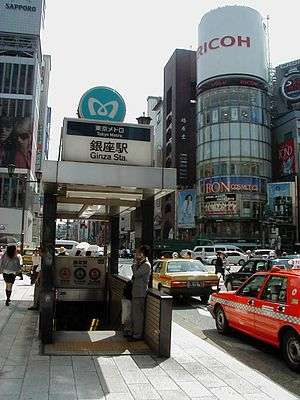Ginza Station
G09 H08 M16 Ginza Station 銀座駅 | |
|---|---|
 | |
| Location |
4-1-2 Ginza, Chuo City, Tokyo Japan |
| Operated by | Tokyo Metro |
| Line(s) | |
| Connections | Toei Bus |
| Other information | |
| Station code | G-09, M-16, H-08 |
| Website |
www |
| History | |
| Opened | 1934 |
| Traffic | |
| Passengers (FY2011) | 241,513 daily |
| Location | |
 Ginza Station Location within Japan | |
Ginza Station (銀座駅 Ginza-eki) is a subway station in Chūō, Tokyo, Japan, operated by the Tokyo subway operator Tokyo Metro. It serves the Ginza commercial district, and is the fourth-busiest Tokyo Metro station after Ikebukuro, Kita-senju, and Ōtemachi.
Lines
Ginza Station is served by the following three Tokyo Metro lines.
- Tokyo Metro Ginza Line (G-09)
- Tokyo Metro Marunouchi Line (M-16)
- Tokyo Metro Hibiya Line (H-08)
Station layout
Each line has an island platform serving two tracks. The Ginza and Marunouchi Line platforms are located separately on the 2nd basement (B2F) level, while the Hibiya Line platforms are located on the 3rd basement (B3F) level.
Platforms
| 1 | G Tokyo Metro Ginza Line | for Akasaka-mitsuke, Omote-sando, and Shibuya |
| 2 | G Tokyo Metro Ginza Line | for Nihombashi, Ueno, and Asakusa |
| 3 | M Tokyo Metro Marunouchi Line | for Yotsuya, Shinjuku, Ogikubo, and Nakano-fujimicho |
| 4 | M Tokyo Metro Marunouchi Line | for Otemachi, Korakuen, and Ikebukuro |
| 5 | H Tokyo Metro Hibiya Line | for Roppongi and Naka-meguro |
| 6 | H Tokyo Metro Hibiya Line | for Ueno and Kita-senju TS Tobu Skytree Line for Kuki and Minami-Kurihashi |
The song "The Love Story of Ginza" (銀座の恋の物語 Ginza no Koi no Monogatari) by Yujiro Ishihara and Junko Makimura is to be used as the departure melody on the Hibiya Line platforms from spring 2016.[1]
Adjacent stations
|
History
Ginza Station opened on the Ginza Line on 3 March 1934.[2] The Marunouchi Line began service to Ginza on 15 December 1957,[2] and the Hibiya Line platforms opened on 29 August 1964.[2]
Passenger statistics
In fiscal 2011, the station was used by an average of 241,513 passengers daily.[2]
Surrounding area
An underground passage connects with the following stations, allowing transfer on foot.
- Ginza-itchōme (Tokyo Metro Yūrakuchō Line)
- Higashi-Ginza (Tokyo Metro Hibiya Line, Toei Asakusa Line)
- Hibiya (Tokyo Metro Hibiya Line, Tokyo Metro Chiyoda Line, Toei Mita Line)
- Yūrakuchō (Tokyo Metro Yūrakuchō Line, Yamanote Line, Keihin-Tōhoku Line)
 Marunouchi Line (October 2007)
Marunouchi Line (October 2007) Hibiya Line (February 2018)
Hibiya Line (February 2018)
References
- ↑ 日比谷線 秋葉原駅・銀座駅、千代田線 乃木坂駅 発車メロディ導入曲決定! [Departure melodies to be introduced at Hibiya Line Akihabara and Ginza Stations and Chiyoda Line Nogizaka Station]. News release (in Japanese). Japan: Tokyo Metro. 20 January 2016. Retrieved 20 January 2016.
- 1 2 3 4 Terada, Hirokazu (19 January 2013). データブック日本の私鉄 [Databook: Japan's Private Railways]. Japan: Neko Publishing. pp. 214–215. ISBN 978-4-7770-1336-4.
External links
| Wikimedia Commons has media related to Ginza Station. |
- Ginza station information (Tokyo Metro) (in Japanese)
Coordinates: 35°40′16″N 139°45′54″E / 35.67123°N 139.76500°E